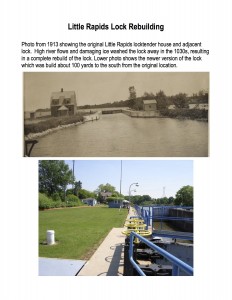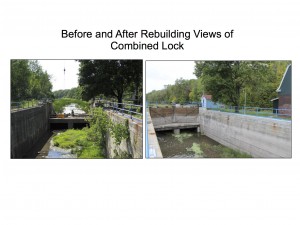History
How the locks were created
In 1838, Wisconsin Territorial Governor Henry Dodge asked congressional approval for the sale of 150,000 acres of land to fund improvements of the Fox and Wisconsin Rivers. Congress approved, noting the military importance of a canal to facilitate movement of troops from the Great Lakes to the Western frontier. The Army Corps of Engineers recommended a lock and dam system and various private companies formed to promote and build the waterway.
Morgan L. Martin is often credited with playing an important early political role in creation of the Fox River Locks System. Martin was instrumental in convincing Congress to acquire the needed real estate for improvement of the Fox River waterway. At the time, Morgan L. Martin was a Congressional Delegate representing the Wisconsin Territory. This was two years before Wisconsin would be named a state.
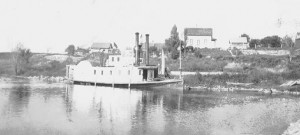 Dams on the Fox River were needed to move commerce up/down the river. Prior to dams, vessels had to portage the dangerous rapids along the river route. Portaging meant extra effort and time to unload the canoes, make multiple trips carrying cargo, then reload canoes on the other side of the rapids. To businessmen-entrepreneurs, that created additional cost. Creating dams at key points allowed the river to back up into pools which allowed heavily-loaded transport canoes to safely move cargo. In order to navigate around the dams, locks were needed.
Dams on the Fox River were needed to move commerce up/down the river. Prior to dams, vessels had to portage the dangerous rapids along the river route. Portaging meant extra effort and time to unload the canoes, make multiple trips carrying cargo, then reload canoes on the other side of the rapids. To businessmen-entrepreneurs, that created additional cost. Creating dams at key points allowed the river to back up into pools which allowed heavily-loaded transport canoes to safely move cargo. In order to navigate around the dams, locks were needed.
Martin’s grand vision was to establish a water-route between the Great Lakes and the Gulf of Mexico. He (and many others) were well aware that the lower Fox River waterway meandered within one mile of the Wisconsin River at Portage, Wisconsin. The ambitious plan was to dig a canal connecting the two river-watersheds which would in turn, provide the enticing promise of inter-continental river travel.
By the mid 1850s, there were three dams and locks constructed and the taming of the mighty Fox River was underway. In 1872 the Corps assumed supervision of the waterway.
Commerce rises along the banks of the Fox
In 1867 the Corps reported that “[t]he country between Berlin and Portage is almost entirely dependent on the river for transportation”. But the impact of railroads were soon felt. Travel and commerce on the Lower Fox declined by the 1880s to a few hundred tons of wheat per month during harvest.
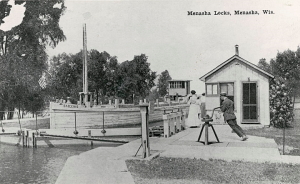 Large-scale papermaking took root on the lower Fox River by the 1880s, after the first wood pulp mill began operations in Appleton in 1871. Most of the paper mills on the Fox were converted flour mills, and product went to market on the waters of the Fox River and on newly built railroads.
Large-scale papermaking took root on the lower Fox River by the 1880s, after the first wood pulp mill began operations in Appleton in 1871. Most of the paper mills on the Fox were converted flour mills, and product went to market on the waters of the Fox River and on newly built railroads.
The Army Corps of Engineers worked diligently throughout the last quarter of the nineteenth and part of the twentieth century to rebuild locks and dams on the Lower Fox River. New locks notwithstanding, the system never saw its traffic increase appreciably in the first 30 years of the century – the system was significantly affected by the railroad, which provided year round shipping, since ice rendered the canal unusable during winter months.
 By 1922, dredging halted, as annual commercial traffic on the Fox decreased dramatically. That same year, the Corps report recommended closing the Upper Fox through Portage and Eureka, but Congress failed to act on the proposal. The Corps finally closed the Upper Fox to navigation between Portage and Eureka in 1951 and transferred it to the state as a recreational waterway. Occasional commercial shipping on the lower Fox River continued until 1959 and the last vessel to navigate the entire length of the system was the Valley Queen 2.
By 1922, dredging halted, as annual commercial traffic on the Fox decreased dramatically. That same year, the Corps report recommended closing the Upper Fox through Portage and Eureka, but Congress failed to act on the proposal. The Corps finally closed the Upper Fox to navigation between Portage and Eureka in 1951 and transferred it to the state as a recreational waterway. Occasional commercial shipping on the lower Fox River continued until 1959 and the last vessel to navigate the entire length of the system was the Valley Queen 2.
Lock construction on the Lower Fox River
There are three types of locks on the Lower Fox River: stacked stone rubble, quarried stone and reinforced concrete. Each one represents a specific stage in the evolution of lock construction in the United States. Their chambers are from 35-36 feet wide by 144-146 feet long. The lift on the system varies from 7.2 to 13.6 feet per lock. All mechanical operation on the system is the result of manual labor and an innovative use of hydraulic engineering.

Quarried stone locks are the most prominent in the Lower Fox system. They are found at the four Appleton locks, Cedars, Little Chute Lock 2, Combined Locks and the Kaukauna Locks. These locks were built to replace composite/rubble stone locks, and have chambers constructed of quarried stone blocks, the tops of which are capped with stone coping or concrete. Each of the lock’s four gates is constructed of horizontally laid, squared wooden timbers. Adjacent to each gate is a concrete platform with a tripod. A vertical shaft, to which a handle is fixed, extends the height of the tripod connected to a handle. The bottom of the shaft contains a gear that drives a horizontally placed spar, the end of which is attached to a lock gate. Depending on which way the handle is turned, the spar is taken in or pushed out, thus opening or closing the gate. The locks are flooded by butterfly valves immediately upstream from the chamber. As the valves are opened, water passes into a chamber with a 90 degree turn and then straight into the chamber. Each valve is adjusted by a geared mechanism at the top of the lock. The lock is discharged through six small butterfly valves at the bottom of the downstream gates. There are three valves per gate, all of which are operated by levers atop each gate.
Composite locks were among the earliest used in the U.S. Rubble stones provide the structural basis for these locks. The stones are covered with planks, which form the lining of the lock and protect a boat’s hull from sharp edges. The gates, valves and other working parts are the same as those found on the quarried stone locks. In the Lower Fox system, the remains of the Kaukauna guard lock and the lock at Kaukauna 5 are composite structures.
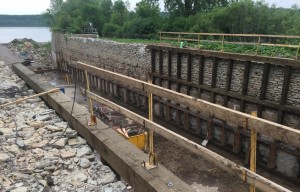 Concrete locks were pioneered in the U.S. in the 1890s in Illinois. These structures are very simple because the entire lock is built of reinforced concrete, except the gates. There are four concrete locks on the Lower Fox at Rapid Croche, Little Kaukauna, DePere and Menasha. Each has four steel gates and operates in the same fashion as the others discussed above.
Concrete locks were pioneered in the U.S. in the 1890s in Illinois. These structures are very simple because the entire lock is built of reinforced concrete, except the gates. There are four concrete locks on the Lower Fox at Rapid Croche, Little Kaukauna, DePere and Menasha. Each has four steel gates and operates in the same fashion as the others discussed above.
(Source: Army Corps of Engineers)
Locks threaten to close, gain new life
In the early 1980s, the Army Corps of Engineers recommended the locks system be dismantled due to decreased use by commercial vessels. For decades, the Corps had made no repairs to the locks. Local leaders, elected officials, and federal officials spent additional years debating who should have responsibility for the locks. Starting in 1984, local leaders and elected representatives had a vision for maintaining the historic, recreational, and economic viability of the system and eventually arranged the transfer of the sytem from the Corps to the State of Wisconsin in 2004.
In 2001, the state legislature approved a law creating the Fox River Navigational System Authority (FRNSA) which maintains and operates the Fox Locks system. A community-wide effort from FRNSA board members, local citizens and businesses resulted in raising the funds necessary to manage the system. Today the organization functions as an independent state authority with a board of directors appointed by the Governor including two members each from Brown, Outagamie and Winnebago counties; and three representatives one from the Department of Natural Resources, one from the Department of Transportation and one from the State Historical Society. The Authority leases the lock system from the state of Wisconsin.
Restoring the Locks
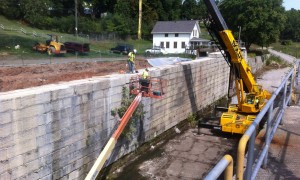 The Fox River Locks are listed on the National Register of Historic Places, so renovation is not only executed for public access, but for historical preservation. Restoration of all but one of the 17 locks in Appleton, Menasha, Little Chute, Combined Locks, and DePere was started in 2005 and completed in phases. The lock at Rapide Croche will remain closed to prevent aquatic invasive species from migrating from the Great Lakes to the Fox River and Lake Winnebago. In 2015, the ten-year lock restoration project was completed on time and under budget, returning the sytem to working order for navigation of large portions of the Fox River.
The Fox River Locks are listed on the National Register of Historic Places, so renovation is not only executed for public access, but for historical preservation. Restoration of all but one of the 17 locks in Appleton, Menasha, Little Chute, Combined Locks, and DePere was started in 2005 and completed in phases. The lock at Rapide Croche will remain closed to prevent aquatic invasive species from migrating from the Great Lakes to the Fox River and Lake Winnebago. In 2015, the ten-year lock restoration project was completed on time and under budget, returning the sytem to working order for navigation of large portions of the Fox River.
The seventeen locks visible today have gone through some form of rebuilding and restoration since the original construction took place over 150 years ago. Periods of heavy industrial use and the constant grind of harsh climate has taken its toll on these structures. Without the investment in upkeep and restoration, the lock “system” wouldn’t be nearly what it is today. Check out the four “before-after” examples of the system restoration work.
Timeline
A look back at some notable dates and events with brief descriptions.
- 1825 Construction of Erie Canal completed, idea of connecting Green Bay and Prairie du Chien via water becomes reality
- 1848 Wisconsin becomes a state.
- 1849 Construction begins on Fox & Wisconsin River improvements
- 1851 Contracts awarded for lock construction at Kaukauna and Little Chute
- 1866 Wisconsin Improvement Company, owner of the lock project, declared bankruptcy
- 1870 Green Bay and Mississippi Canal Company takes over management of the locks
- 1872 United States Army Corps of Engineers acquires navigational control of the waterway
- 1886 U.S. Army Corps of Engineers abandons Wisconsin River portion of locks system
- 1922 Dredging for commercial traffic on the Fox River halts
- 1959 Last vessel navigates the full length of the Fox River
- 1982 Army Corps of Engineers recommends the lock system is dismantled
- 1984 Local citizens and elected officials start a campaign to fund and keep the locks open
- 1993 Individual locks named to the National Register of Historic Places
- 2001 State statute 237 creates the Fox River Navigational System Authority
- 2004 Ownership of the lock system is transferred from the U.S. Army Corps of Engineers to the State of Wisconsin
- 2005 Repair and renovation begins on the lock system
- 2015 All locks are restored to full operational functionality

